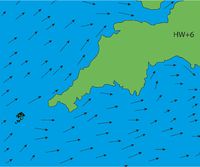
Animation 2: Tidal patterns around West Cornwall and the Isles of Scilly (source: redrawn and modified from Admiralty 1998)
Case Studies:
Reconstructing the island landscape of Scilly
Prehistoric fishing and hunting on Scilly
Prehistoric wayfaring on Scilly
It can be shown that prehistoric Scillonians were making sea journeys from as early as the 6th millennium BC (Robinson 2007). Voyages between the archipelago and the mainland are demonstrated through the presence of imports such as axes, pottery and animals (Clough and Cummins 1988, 141-264; Johns 2012; Ratcliffe and Straker 1996; Robinson 2007, 134-42).The difficulties of such journeys undertaken in prehistory are often the subject of speculation, but what is clear is that prehistoric Scillonians did make this journey in small boats. Thomas states in relation to the journey from mainland Cornwall to Scilly that: 'the undertaking was formidable, but it was never insuperable' (Thomas 1985).
Journeys would be infrequent and only undertaken in ideal conditions. On a clear day, Lands End is visible on the journey from Scilly to the mainland and this sight of the destination, from point of departure, was probably important. The return journey is more problematic as Scilly, while visible from the cliffs of Lands End, is not visible from sea-level until within a few kilometres of the islands. Navigation in this instance must have been achieved by following a backsight taken from familiar landmarks on the Cornish mainland. Tidal cycles form a predictable temporal pattern of movement that both restricts and facilitates movement on the sea. Through this structuring of movement we can begin to discuss the times, places and problems of movement in and around coastal and offshore waters. The timings of journeys would take advantage of the predictable shifting daily cycle of tidal currents (Animation 2). The timing of sailings, to and from the islands to the mainland, would require careful observation of tidal cycles to avoid unfavourable tides. The tidal currents around Scilly today remain unchanged from those during the Neolithic and Bronze Age, although small changes will have occurred between the islands, owing to changes in the configuration of the coastline of the archipelago.

Animation 2: Tidal patterns around West Cornwall and the Isles of Scilly (source: redrawn and modified from Admiralty 1998)
Approach to Scilly from the mainland would have been from the north-east. We can rule out a western or southern approach to the islands as this would have to contend with the innumerable rock pinnacles, ledges and dangerous currents that comprise the Western and Northern Rocks – where tides run strong with confusing eddies and overfalls. These waters rank among the most dangerous in the world (Doodson and Warburg 1973; RYA 1981). This is not to deny that people would have ventured into these areas, since they are particularly rich in fish as result of heavily oxygenated water; however, such journeys would be limited to the few days within the year when conditions would allow. Thus, the dangerous nature of the seas around Scilly structure how people could have approached and moved around the seascape day-to-day. Once within the relatively sheltered water of the eastern seaboard of the islands, access to the interior would be channelled through either Crow Sound or St Mary's Road to the west, or through the deep-water channels of Tean Sound, to the north (Brandon 1999; Admiralty 1998; 2001). Within the interior lagoon of the islands we can envisage two large bays, the first, to the east, spanning between Bar Point and Arthur, while to the west a second is found between Pendrathen and Samson. Similarly, to the north of the archipelago a small bay may once have existed within Tean Sound (Figure 7).
Internet Archaeology is an open access journal based in the Department of Archaeology, University of York. Except where otherwise noted, content from this work may be used under the terms of the Creative Commons Attribution 3.0 (CC BY) Unported licence, which permits unrestricted use, distribution, and reproduction in any medium, provided that attribution to the author(s), the title of the work, the Internet Archaeology journal and the relevant URL/DOI are given.
Terms and Conditions | Legal Statements | Privacy Policy | Cookies Policy | Citing Internet Archaeology
Internet Archaeology content is preserved for the long term with the Archaeology Data Service. Help sustain and support open access publication by donating to our Open Access Archaeology Fund.
File last updated: Fri May 31 2013